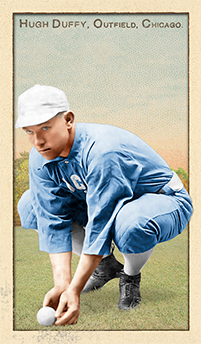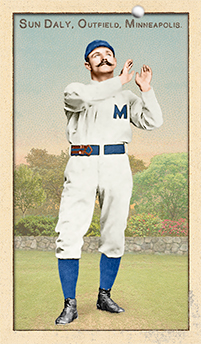
- Series: Beginnings: 1880's
- City: St. Louis
- Team: Whites (WA)
- League: Western Association
Henry Fred Hines (1867-1928) was a fireplug of an outfielder. While his major league experience was ever so brief - two games with the Brooklyn Bridegrooms in 1895 - Hines enjoyed a long career in professional baseball. He began as a teenager in 1887 with the Milwaukee Cream Cities, getting into a mere nine games, but that humble beginning launched him into a 19-season career that didn’t end until 1910 when Hunkey played for and managed the Joliet Jolly-ites/Sterling Infants of the Northern Association. By the time Hunkey became an "Infant," he was 42 years old. The available data show that Hines’ career batting average was .250, precisely what he achieved in those two games in Brooklyn where he got two hits and walked twice in two games. The Illinois native spent most of his minor league time in the greater midwest, but he did venture as far west as the Bay Area’s Oakland Oaks in 1891 and ‘93. He played two seasons for the Detroit Tigers when they were in the Western League, 1900-01. In 1906 Hines was in the deep south playing for the Baton Rouge Cajuns, evidence that baseball afforded the sturdy Hunkey a tour of much of the continent.
- Hines’ best year at the plate was a startling .427 for the Minneapolis Minnies in 1894. This wasn’t a fluke. Hunkey had 586 at bats that career-year when he also clubbed 34 home runs. He never hit more than six in any other season of his long career

- Series: Beginnings: 1880's
- City: Chicago
- Team: White Stockings
- League: National League
- Hall: National Baseball Hall of Fame
Hugh Duffy (1866-1954) is as much a baseball institution as the Hall of Fame that enshrines him. For 68 years he devoted himself to the game he loved and excelled at as few ever have. In 1894 he set the all-time mark with a .440 average while winning the triple crown. He made HOF pitchers look like batting practice coaches: .586 against John Clarkson, .650 vs Cy Young. Amos Rusie was the exception, holding Duffy to a mere .333. So diminutive Cap Anson nearly dismissed him (“We already have a bat boy”), Hugh hustled his way to becoming the only player to hit .300 in four leagues and let the power follow his form (“hit ‘em up the middle”) winning two HR titles. Duffy went on to coach, manage, scout and mentor for a half-century after hanging up his spikes. He was still hitting fungoes eight years after his induction into Cooperstown and delighted in pupil Ted Williams’ success as he sought in vain to eclipse Duffy’s record in 1941.
- Playing career spanned 19 years, primarily in Chicago, Boston and Philadelphia
- Played center field for the Beaneaters next to his “Heavenly Twin,” Tommy McCarthy in right, leading Boston to a pair of pennants
- Elected to Hall of Fame: 1945

- Series: Beginnings: 1880's
- City: Chicago
- Team: Maroons
- League: Western Association
George Brinton McClellan Rooks (nee Ruckser) (1863-1935) had a vanishingly brief stint in the National League, seeing action in five games in left field for the Boston Beaneaters in May of 1891. He had a grand total of 20 plate appearances with 16 official at bats. He had twice as many walks as hits and ended his tour in the majors with a .125 average. He did score a run, allowing him to approach home plate from an alternate direction. This sketch doesn't do justice to a much longer professional experience for the young Chicagoan who had debuted with the Lincoln Tree Planters of the Western League in 1886 before moving on to the Northwestern League's Oshkosh franchise to finish the season. George remained in the league the following year with the LaCrosse Freezers where he was a regular. He hit .333, higher than any teammate with as many at bats. He showed both power and speed with four home runs and 70 stolen bases. Rooks got a cup of coffee in '88 with his hometown Maroons but got into only eight games before being shipped out to the Lima Lushers of the Tri-State League. 1889 would be the second and last time George played an entire season for one team, this time with the Detroit Wolverines of the International League. He was one of four to play 112 games and he produced a fine .303 average, second on the club among regulars.
- Following his sojourn in Boston, Rooks finished out his minor league career primarily close to home with clubs in Wisconsin and Michigan, including the intriguing bi-city squad from Ishpeming-Negaunee in 1892
- George strayed south for his swan song in '93 with Vicksburg of the Mississippi State League
- Although Baseball Reference data list George as right-handed, the Old Judge poses when he was with the Maroons depict a lefty both at bat and throwing

- Series: 1880s: Loving Paupers
- City: Cleveland
- Team: Blues (AA)
- League: American Association
Mortimer Edward Hogan (1862-1923) broke into pro ball in 1883 with the Peoria Reds. The young outfielder got the first of two shots at the big time the following season with the Milwaukee Brewers of the soon-to-be-defunct Union Association. Even had the league survived that turbulent year, it is virtually certain that Hogan's .081 batting average would have doomed him to return to the minors. He spent most of '84 with the Milwaukee Northwestern League club after the UA went belly up. Hogan at least hit his weight here, bumping his average up to .217. The light-hitting Hogan remained in the minors, bouncing from the Southern League to the Western League and to Elmira of the New York State League before returning south to two Georgia squads for most of the '86 season. He moved back to the WL's Leavenworth Soldiers to finish the campaign before getting another opportunity in the majors with the American Association's New York Metropolitans where his .200 average might have been overlooked as the team struggled to a 45-88 record and a dismal seventh place finish. Well, apparently Mort's weak hitting wasn't ignored as the woeful Mets shipped him to Nashville to finish out the '87 season. But all was not dark for Hogan as he was given one last chance at big league glory with the 1888 Cleveland Blues of the AA, where he managed a .227 average. The Cleveland management, having witnessed the futility of Hogan and the Mets the prior year, still held out hope, signaling the eternal optimism that defines America's pastime.
- Perhaps Mortimer had the last laugh as the Blues managed a sixth place finish in '88, an improvement that launched Hogan into retirement at the age of 26
Auction History
Cartophilia
Old Judge Pose: 229-5

- Series: Beginnings: 1880's
- City: Minneapolis
- Team: Millers
- League: Western Association
James J. Daly (1865-1938) compiled a very short major league slash line. Sun made it to the big leagues with the Baltimore Orioles in 1892, joining one of the more ferocious teams of the era. He got into a mere 13 games and went 12-48 for a .250 average with seven RBI for the last-place team. With the likes of McGraw, Hanlon, Stovey and Wilbert Robinson - this was a down year for a team on the cusp of greatness. Already the squad was known for making its own rules and playing with a snarl. Thus, it was unlikely for a new kid to make the big club and Daly soon found himself back in the minors. He had begun playing ball in his hometown of Port Henry, NY and moved into the professional ranks with Portsmouth of the New England League in 1888. The next year he was out west with two Twin Cities clubs where he was photographed by the Old Judge crew. The Goodwin editors note that Daly was the poorest-fielding left fielder in the Western Association at that time. He returned east with Portland and Lebanon in '91 and began the '92 campaign with the Buffalo Bisons of the Eastern League. It is said that Daly acquired his nickname in the Buffalo outfield as he played the position while eschewing sun glasses. His distinctive moniker not enough to gain a toe-hold with the Orioles, Sun shuffled back to Buffalo for the '93-94 seasons. Daly then moved to Rochester for two years before wrapping it up in 1897 with stints for three Pennsylvania franchises: Reading, Scranton and Wilkes-Barre.
- Sun's best year at the plate was 1895 with Rochester where he hit .337 in 128 games, by far his most prolific season
- While his endurance at the pinnacle of his sport was short-lived, Daly set a much finer life-mark by living just long enough to celebrate fifty years of marriage to the mother of their four children




